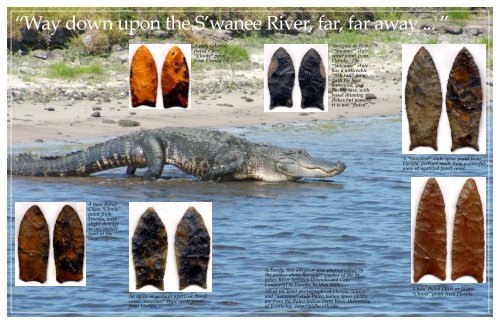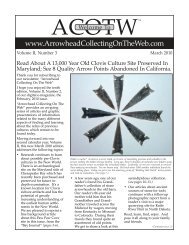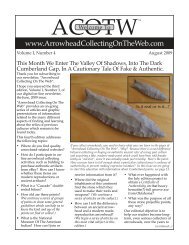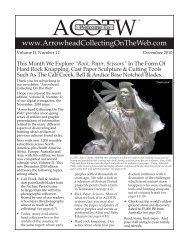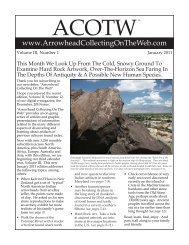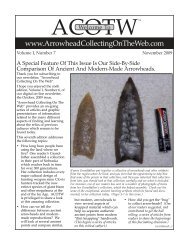Clovis - Arrowhead Collecting On The Web
Clovis - Arrowhead Collecting On The Web
Clovis - Arrowhead Collecting On The Web
Create successful ePaper yourself
Turn your PDF publications into a flip-book with our unique Google optimized e-Paper software.
Knife River Flint quarries shape this North Dakota farm.<br />
<strong>The</strong>se pieces of<br />
Knife River Flint<br />
show the typical<br />
“inclusions” (white<br />
colored bits of<br />
fossilized plant<br />
remains) which we<br />
see in semi-translucent<br />
KRF material.<br />
<strong>The</strong> silicified lignite<br />
also retains the<br />
layered form of the<br />
original coal material,<br />
so it tends to<br />
break in flat pieces<br />
along those layers.<br />
You may be able to<br />
see the lines along<br />
those layers in the<br />
side of the top<br />
chunk.<br />
<strong>The</strong> background photograph shows a farmer’s field in North Dakota which is covered by ancient<br />
dugout pits where native craftsman quarried Knife River Flint from buried deposits of silicified<br />
lignite coal. At some ancient time these coal beds were covered by volcanic ash, from which, in eons<br />
of time, the silica in the ash replaced the lignite in the layers beneath the volcanic ash.<br />
Knife River Flint was prized for its excellent characteristics: sharp tools and relatively easy to work<br />
with, requiring no heat treatment, etc. It was traded far and wide in the Great Plains and beyond.<br />
Photographed for ACOTW by David McDonald.<br />
This cast shows a late-stage preform of a<br />
Folsom point which was cut in half by the<br />
second flute removal ... which dove through<br />
the middle of the blade rather than continuing<br />
for the intended length of the flute.<br />
<strong>The</strong> removal of the fluting blades took place by<br />
striking a small platform prepared at the base<br />
end of the planned projectile point, either by<br />
percussion or indirect percussion. <strong>The</strong> remnant<br />
of the prepared platform remains visible.<br />
<strong>The</strong> two pieces were found four years apart at<br />
the shoreline of Sakakewa Lake in Montrail<br />
County, North Dakota, just west of New<br />
Town.<br />
It is made from Knife River flint, which is<br />
silicified lignite. Shown here at actual size,<br />
with the two pieces joined together when the<br />
cast was produced by Lithic Casting Lab.<br />
This “Scottsbluff” spear point is made from<br />
Knife River Flint. It shows the typical inclusions<br />
from the original lignite. Very nicely<br />
made, and appears glossy with age patina.<br />
Dates to late Paleo/early Archaic period. Found<br />
over much of the United States. 3-1/2” long.<br />
This fluted Knife River Flint spear point shows<br />
the typical inclusions (white colored bits of<br />
fossilized plant material remaining from the<br />
original lignite) which we see in the semi-translucent<br />
KRF material. Very nicely made, and<br />
appears glossy with age patina. Ex C. Shewey.


